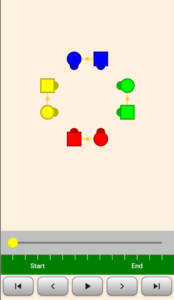My opening post on Norman Doidge’s book The Brain That Changes Itself: Stories of Personal Triumph from the Frontiers of Neuroscience was intended to inspire readers to become lifelong learners for the sake of sustaining healthy brains. Having witnessed firsthand my father’s struggle with dementia and my mother’s Alzheimer’s disease, I’m quite serious about cognitive exercise. My husband is on that bandwagon, too. Square dancing has become our latest adventure.
Square dancing came to America with European settlers and originally took the form of memorized sequences of steps. When African slaves provided music for dances, they began calling out the steps, a practice that became commonplace by the early 1900s. Beginning in the 1930s, an educator by the name of Lloyd Shaw codified the steps and calls to make the dance more accessible to new dancers. It gained in popularity between the 1940s and 1960s, gaining a boost with the folk music revolution.
Here’s how it works:
A square dance involves four couples arranged in a square facing the middle of the square with one couple on each side. A caller provides instructions from a standard collection of roughly 70 moves to which the dancers respond. The moves have variations that can be invoked from a variety of formations. Most calls take between 4 and 32 beats. The caller may provide the instructions as an overlay to a lively instrumental piece or may work them into a vocal performance of a given tune. In either case, dancers must be on alert to hear the calls, watch their fellow dancers, and execute the correct steps.
 My husband and I had some exposure to square dancing as grammar school students, but that was a LONG time ago. Fortunately, the local area’s square dancing clubs offer a series of 10 lessons covering the basics. Their members volunteer as “angels” to help the newbies get acquainted with the calls and moves. These experienced dancers model the correct form and provide gentle nudges and tugs to help us get in the right places at the right times.
My husband and I had some exposure to square dancing as grammar school students, but that was a LONG time ago. Fortunately, the local area’s square dancing clubs offer a series of 10 lessons covering the basics. Their members volunteer as “angels” to help the newbies get acquainted with the calls and moves. These experienced dancers model the correct form and provide gentle nudges and tugs to help us get in the right places at the right times.
Even though I’ve had a fair bit of dance training and am a reasonably quick study, I really have to pay attention to figure out what’s coming next and remember what I’m supposed to do. I’ve also found that I need to do a little bit of homework between classes to reinforce what I have learned. Fortunately, there’s a great on-line tool called “Taminations” that provides written instructions and animations to help me visualize the steps and my parts in them. Hats off to my husband for whom this exercise is a lot more challenging!
So why do I think square dancing is good for cognitive health?
Dr. Sanjay Gupta identified five key factors that contribute to a healthy brain: exercise, learning, sleep, diet, and socialization. Square dancing ticks off three of the five boxes. Dancing in any form involves movement, and square dancing is no exception. Classes and scheduled dances generally last 2 hours with just a few short breaks to catch a breath and chat. As noted earlier, this particular form of dance demands careful attention to receive and act on the latest instruction. While particularly challenging for newbies, it continues to demand concentration even for those who’ve been dancing for years. And we’ve found the square dancing community to be warm and welcoming – a very good resource for social connection!